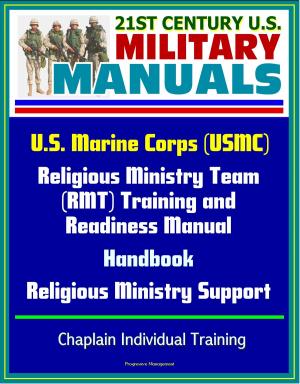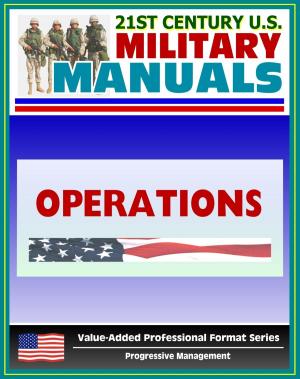The DSCA Corps: Bridging the Gap Between the Profession of Arms and Domestic Operations - Defense Support to Civil Authorities Case Study of Hurricane Sandy and Cascadia Rising Earthquake Exercise
Nonfiction, History, Military, United States, Social & Cultural Studies, Social Science| Author: | Progressive Management | ISBN: | 9780463576922 |
| Publisher: | Progressive Management | Publication: | July 7, 2018 |
| Imprint: | Smashwords Edition | Language: | English |
| Author: | Progressive Management |
| ISBN: | 9780463576922 |
| Publisher: | Progressive Management |
| Publication: | July 7, 2018 |
| Imprint: | Smashwords Edition |
| Language: | English |
This important December 2017 report has been professionally converted for accurate flowing-text e-book format reproduction.
Defense Support to Civil Authorities (DSCA) is an important mission for the Army and the Department of Defense. Inherent to this mission, and critical in its execution, is effective liaison, coordination, and integration of Army forces into the emergency response structures of local, state, and federal civilian agencies. An examination of two cases, the 2012 response to Hurricane Sandy and the 2016 Cascadia Rising earthquake response exercise, identifies several shortfalls in integration and coordination between the Army, other service components, and civil authorities. This thesis examines these shortfalls and provides a potential solution to correct them for future DSCA missions. This thesis suggests that a creation of a functional area and force structure within the Army that is dedicated to the Army's DSCA mission would bridge the gap between the Army and its civilian partners at all levels. The new DSCA Corps would be responsible for civil-military liaison, relationship building, and integrated planning prior to a disaster. During a disaster, the DSCA Corps would provide a core of DSCA subject matter experts (SMEs) to facilitate the rapid deployment and integration of Title 10 and Title 32 forces in support of the civilian Incident Command System (ICS).
The problem lies with the Army; it has both a lack of understanding of the civilian emergency response structures and processes and also a tendency to take charge of operations rather than deferring to civil authorities. In order to save lives and mitigate property damage, it is important for multiple agencies to rapidly integrate and cooperate to respond to disasters. The Army needs to find a way to improve its ability to integrate with civil authorities rapidly and effectively in order to make a positive impact on disaster response operations rather than detracting from them. This thesis will research the current conditions and how we can improve upon them.
I. INTRODUCTION * A. PROBLEM STATEMENT * B. RESEARCH QUESTION(S) * C. LITERATURE REVIEW * 1. Overview * 2. DSCA and the DOD * 3. DSCA and the United States Army * 4. Conclusion * D. RESEARCH DESIGN * II. DSCA IN THE U.S. ARMY * A. INTRODUCTION * B. DEFINING DSCA * C. LAWS GOVERNING DSCA * D. THE ARMY DSCA PROCESS * E. HISTORICAL EXAMPLES * F. NRF AND NIMS FOLLOWING 9/11 * G. DUAL STATUS COMMAND * H. EMERGENCY MANAGEMENT ASSISTANCE COMPACT AND IMMEDIATE RESPONSE AUTHORITY * I. CONCLUSION * III. MANAGING HURRICANES AND EARTHQUAKES: SHORTFALLS IN INTEGRATION * A. INTRODUCTION * B. CASE STUDY 1: HURRICANE SANDY * 1. Overview * 2. Successes * 3. Shortfalls Highlighted by Case Study * 4. Conclusions Derived from Case Study * C. CASE STUDY 2: CASCADIA RISING * 1. Overview * 2. Successes * 3. Shortfalls Highlighted by Case Study * 4. Conclusions Derived from Case Study * D. CONCLUSION * IV. CURRENT SHORTFALLS * A. INTRODUCTION * B. CIVIL-MILITARY LIAISON * C. PRE-DISASTER RELATIONSHIP BUILDING * D. SOLDIER EDUCATION AND TRAINING * E. KNOWLEDGE AND EXPERTISE * F. PLANNING AND ANTICIPATION OF NEEDS * G. CONCLUSION * V. A DSCA CORPS: A POSSIBLE SOLUTION? * A. INTRODUCTION * B. SOLUTION * C. FUNCTIONAL AREA 20 - DSCA * 1. Mission * 2. Proponent * 3. Purpose * 4. Functions * 5. Military Occupational Specialty (MOS) Structure * 6. Training and Education * 7. Insignia * D. FORCE STRUCTURE * 1. DSCA Groups * 2. DSCA Battalions * 3. DSCA Companies * 4. Additional Force Structure - DCE/EPLO * E. STATIONING * 1. Regional Alignment * 2. Subject Matter Experts * 3. Relationship with FEMA Regions/States * F. TEMPLATE FOR CREATING A NEW BRANCH * G. CONCLUSION * VI. IMPLEMENTATION AND CONCLUSION * A. INTRODUCTION * B. CHALLENGES AND LIMITATIONS * 1. Challenges * 2. Limitations * C. TRANSITION * 1. Creation * 2. Fielding * 3. Integration
This important December 2017 report has been professionally converted for accurate flowing-text e-book format reproduction.
Defense Support to Civil Authorities (DSCA) is an important mission for the Army and the Department of Defense. Inherent to this mission, and critical in its execution, is effective liaison, coordination, and integration of Army forces into the emergency response structures of local, state, and federal civilian agencies. An examination of two cases, the 2012 response to Hurricane Sandy and the 2016 Cascadia Rising earthquake response exercise, identifies several shortfalls in integration and coordination between the Army, other service components, and civil authorities. This thesis examines these shortfalls and provides a potential solution to correct them for future DSCA missions. This thesis suggests that a creation of a functional area and force structure within the Army that is dedicated to the Army's DSCA mission would bridge the gap between the Army and its civilian partners at all levels. The new DSCA Corps would be responsible for civil-military liaison, relationship building, and integrated planning prior to a disaster. During a disaster, the DSCA Corps would provide a core of DSCA subject matter experts (SMEs) to facilitate the rapid deployment and integration of Title 10 and Title 32 forces in support of the civilian Incident Command System (ICS).
The problem lies with the Army; it has both a lack of understanding of the civilian emergency response structures and processes and also a tendency to take charge of operations rather than deferring to civil authorities. In order to save lives and mitigate property damage, it is important for multiple agencies to rapidly integrate and cooperate to respond to disasters. The Army needs to find a way to improve its ability to integrate with civil authorities rapidly and effectively in order to make a positive impact on disaster response operations rather than detracting from them. This thesis will research the current conditions and how we can improve upon them.
I. INTRODUCTION * A. PROBLEM STATEMENT * B. RESEARCH QUESTION(S) * C. LITERATURE REVIEW * 1. Overview * 2. DSCA and the DOD * 3. DSCA and the United States Army * 4. Conclusion * D. RESEARCH DESIGN * II. DSCA IN THE U.S. ARMY * A. INTRODUCTION * B. DEFINING DSCA * C. LAWS GOVERNING DSCA * D. THE ARMY DSCA PROCESS * E. HISTORICAL EXAMPLES * F. NRF AND NIMS FOLLOWING 9/11 * G. DUAL STATUS COMMAND * H. EMERGENCY MANAGEMENT ASSISTANCE COMPACT AND IMMEDIATE RESPONSE AUTHORITY * I. CONCLUSION * III. MANAGING HURRICANES AND EARTHQUAKES: SHORTFALLS IN INTEGRATION * A. INTRODUCTION * B. CASE STUDY 1: HURRICANE SANDY * 1. Overview * 2. Successes * 3. Shortfalls Highlighted by Case Study * 4. Conclusions Derived from Case Study * C. CASE STUDY 2: CASCADIA RISING * 1. Overview * 2. Successes * 3. Shortfalls Highlighted by Case Study * 4. Conclusions Derived from Case Study * D. CONCLUSION * IV. CURRENT SHORTFALLS * A. INTRODUCTION * B. CIVIL-MILITARY LIAISON * C. PRE-DISASTER RELATIONSHIP BUILDING * D. SOLDIER EDUCATION AND TRAINING * E. KNOWLEDGE AND EXPERTISE * F. PLANNING AND ANTICIPATION OF NEEDS * G. CONCLUSION * V. A DSCA CORPS: A POSSIBLE SOLUTION? * A. INTRODUCTION * B. SOLUTION * C. FUNCTIONAL AREA 20 - DSCA * 1. Mission * 2. Proponent * 3. Purpose * 4. Functions * 5. Military Occupational Specialty (MOS) Structure * 6. Training and Education * 7. Insignia * D. FORCE STRUCTURE * 1. DSCA Groups * 2. DSCA Battalions * 3. DSCA Companies * 4. Additional Force Structure - DCE/EPLO * E. STATIONING * 1. Regional Alignment * 2. Subject Matter Experts * 3. Relationship with FEMA Regions/States * F. TEMPLATE FOR CREATING A NEW BRANCH * G. CONCLUSION * VI. IMPLEMENTATION AND CONCLUSION * A. INTRODUCTION * B. CHALLENGES AND LIMITATIONS * 1. Challenges * 2. Limitations * C. TRANSITION * 1. Creation * 2. Fielding * 3. Integration















